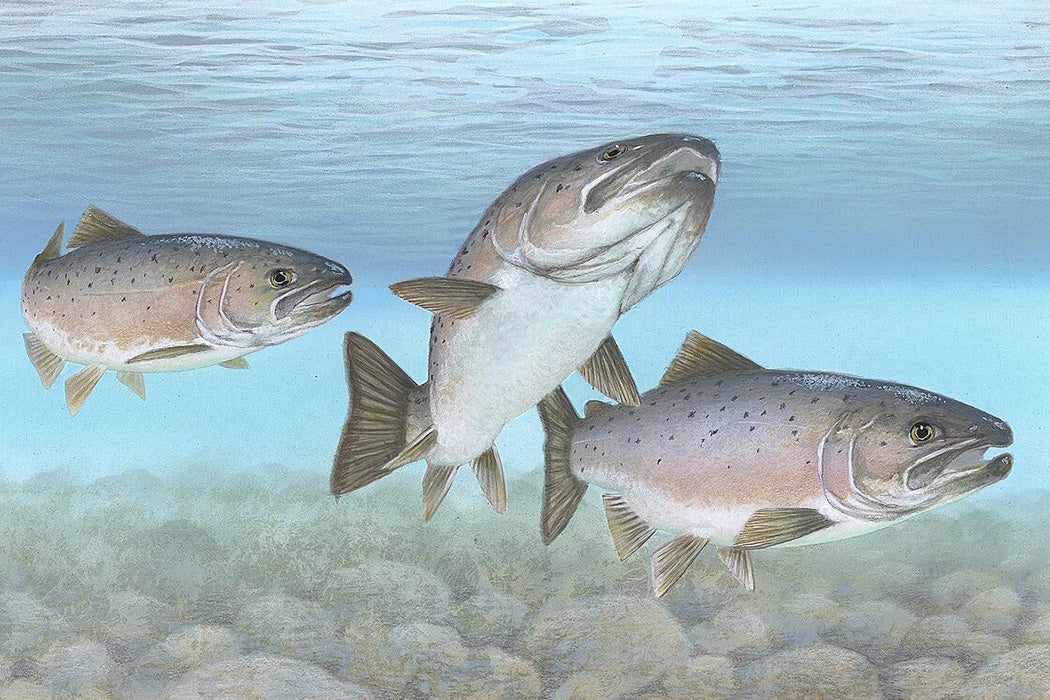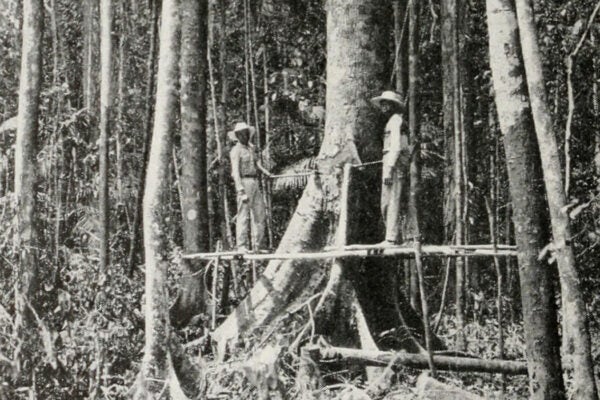In 1938, already divided over fundamental aspects of the fish’s life history, the world’s foremost scientific experts gathered in Canada for a Conference on Salmon Problems.
One side of the debate aligned with conventional wisdom: salmon are born in freshwater and travel downriver to sea. After years in the ocean, during which they may migrate great distances to feed, they eventually return, remarkably, to spawn in the same natal streams in which they were born. Fish from each tributary form identifiable “races” with shared traits and genetics, perpetuated by their homing instinct.
But the pre-eminent Canadian biologist A. G. Huntsman felt that a good story was being prioritized over simpler alternatives. Salmon movement, he believed, was strongly influenced by ocean currents, which could coincidentally return fish close to home. Physiological differences between salmon populations could easily be explained by environmental factors—without any genetics.
Yet in the following decades, new science largely supported the homing salmon story. The majority of salmon return to their birthplace, led by a keen sense of smell and a feel for the Earth’s magnetic field. And while environment influences development, salmon that share an established spawning ground are indeed genetically distinguishable from others.
Weekly Newsletter
But with so much still to come, Huntsman scored a small concession at the Conference on Salmon Problems. Referring to “races” of salmon from any particular river or region implied a hereditary relationship for which, at the time, there was no good evidence. Instead, the assembled scientists agreed to call a discrete salmon population something they felt was relatively neutral: a stock.
Today, salmon “stock” is still used by fishermen, economists, and conservationists, and it’s enshrined in law. Precise definitions depend on discipline; legal definitions depend on jurisdiction. Many interpretations ultimately have little to do with homing, natal streams, or genes.
“Two people can say a lot of different things using the same word,” says Louise Chavarie, an ecologist at the Norwegian University of Life Sciences who studies salmon and related fish.
But generally, a stock is something that has been or can be commoditized, quantified, and valorized. The numbers say that, as with many other commercially and ecologically important fish, salmon stocks across the world are at record lows, continuing decades-long downwards trends. Because the stock concept is central to our understanding of that decline, it’s worth asking to what extent the word choice reflects, reinforces, or reshapes contemporary attitudes about fish and more.
A Double Life
As explained in the mid-twentieth century by George S. Meyers, the salmon’s dual lifestyle is called anadromy. That is, they migrate upriver to freshwater to reproduce and spend part of their life in the ocean. Some species of eel are a popular example of the opposite: catadromy, wherein they spawn in the sea but live in bodies of freshwater. Taken together, these are the diadromous fishes.
Salmon begin life in freshwater streams or lakes. After a year or two of growth, gradually moving downstream and passing through youthful developmental stages (alevin, fry, parr), they prepare for life in saltwater, undergoing a process that biologists call the Parr-Smolt transformation, or smoltification. Adult fish may travel a thousand miles to reach communal feeding grounds, where they prepare for their arduous return journey. Spawning adults transform yet again, from roughly a silvery torpedo, to, as an example, the vivid red and dark green, with humped-back and hooked rostrum, of a male Chinook salmon.
The details vary greatly between and even within species. One example, with major implications for population dynamics, is that the many species of Pacific salmon tend to spawn just once—the effort kills them—but the one native species of Atlantic salmon can reproduce multiple times.
Evaluating the variation within or between populations is complicated by a number of factors, such as yearly fluctuations, environmental interactions, commercial fishing pressures, and some of the unintended consequences of hatcheries, or farmed salmon. And there are key exceptions to the rules, such as the occasional “straying salmon,” which spawn at new rivers, or “sneaking jacks,” male salmon that return from sea a year earlier than most of their counterparts as a reproductive strategy.
In her account of the 1938 salmon homing debate, Jennifer Hubbard describes a great buildup to Huntsman’s public expression of disagreement, writing that he “had tilted at the windmill of an accepted yet unproved scientific paradigm, and the whole establishment trembled.”
More to Explore
Fish Addiction: An Ancient Greek Paranoia
Huntsman wrote to the editors of Science in March 1937 that salmon migration would be better described as “random wanderings.” He returned just months later, relating an experiment in which young salmon were transplanted from one Canadian river, the Restigouche, to another, the Apple. Few differences were observed between transplants and locals—the Restigouche salmon, which usually remained at sea for three years, returned to the Apple, and did so after two years along with the Apple natives. Huntsman called for more evidence from the homing true believers.
“While such a result is no proof that races do not exist elsewhere, it is evidently desirable that local populations should not be considered to be racially distinct until heritable differences have been definitely demonstrated,” he wrote.
Soon after the 1938 conference, a young biologist named Bradley T. Scheer published a review of the available evidence, gathering the results of many tracking studies. He summarized what he found point-by-point.
“Anadromous salmon and trout hatched and reared in a particular region will, when seeking fresh water to spawn, seek out and return in the great majority of cases to the same region, even from considerable distances,” he concluded. “No mechanism is known by means of which fishes could so return.”
In 1951, Arthur Hasler and Warren Wisby shared a plausible explanation for salmon homing and described experiments investigating three points: that streams have signature odors; that salmon can learn these smells and remember them long-term; and that fish use that sense memory to help them return to their precise birthplaces after years away. Hasler is often credited with solving the great mystery of salmon homing, and he was reportedly inspired by a wave of nostalgia he felt visiting near his childhood home in Utah, triggered by the smell of native plants.
In Scientific American in 1955, Hasler detailed a decade of research into what came to be called olfactory imprinting. In laboratory experiments, researchers were able to condition young salmon (the Parr-Smolt transformation is now considered a critical period for learning) to swim towards a particular smell in order to receive a food reward and to avoid another odor that came with an electric shock. Field work confirmed the unique smell of streams and showed that salmon with damaged noses would navigate at random. Hasler didn’t refer to stocks or races of salmon, but he made his position clear, writing that “populations in streams not far apart follow distinctly separate lines of evolution.”
The article was written squarely in the golden age of American dam building, and, in the face of the relatively new problem of dams blocking salmon runs, Hasler also raised the possibility of guiding salmon to new spawning grounds with artificial scents. It’s still being investigated today, including with the distinctive odor of brewery discard. His concern predates a widespread re-evaluation of the social and ecological impacts of dams, and in some cases, their decommissioning and rehabilitation.
Subsequent research has gone deeper into chemical or neurological aspects of olfactory imprinting and geomagnetic navigation, which seems to aid salmon homing at longer distances. Huntsman himself would soften on homing, but questions remained about races of salmon, salmon stock, and how to define them.
Stock Options
Anadromous fish present a special challenge to defining stock. Categorized by their freshwater origins, there are sometimes remarkable physical and behavioral differences between them. But in the sea, their ranges overlap, and the fish physically intermingle, subject to the same conditions (and fishing fleets). It’s reasonable to consider either or both of these life stages as an important sub-population of the species, which one might call a stock.
Chavarie has experienced a general divide between North American and European approaches to salmon stocks. In the United States and Canada, laws generally allow for protections below the species level, whereas in Europe, though fisheries managers do consider sub-populations, there is less legal recognition. And depending on the country, different levels of government or departments may manage freshwater and saltwater fisheries, putting salmon in an odd regulatory position among fish.
In the United States, many of the rules around ocean fisheries management are rooted in the Magnuson-Stevens Act, passed in 1976. The law defines fish broadly to include “finfish, mollusks, crustaceans, and all other forms of marine animal and plant life other than marine mammals and birds.” And “‘stock of fish’ means a species, subspecies, geographical grouping, or other category of fish capable of management as a unit.”
Under the Endangered Species Act, “evolutionarily significant units,” defined by their value to the gene pool, are protected rather than species of salmon as a whole. This approach has allowed for finer-grained management of salmon, but it’s been criticized for a narrow view of salmon diversity. Today, there are twenty-eight protected “population groups” of salmon and steelhead trout. NOAA managed 506 “stocks and stock complexes” in 2023.
Genetics and heredity define stock in some modern contexts, but for the 1930s salmon homing debate, the implications of genetic dividing lines were very different.
“On the race question, Huntsman was raising valuable objections to the assumptions which guided his scientific opponents,” Hubbard writes. “His task was made all the harder in the world of pre-Second World War biology by the facts that social racial assumptions were widespread, and racism even acceptable.”
With his ecological view of salmon development and differentiation, Huntsman was at least pressing back against a potentially flattening assumption of static biological races in salmon, rooted in a common view of humans.
Yet stock may have its own problematic associations. In a 2017 critique of stock in the broader fisheries context, first applied to herring in 1898, Jennifer Telesca notes various meanings of the word, including those related to heritage, agriculture, and finance. Stock, Telesca writes, is part of the simplification that goes with seeking out a “maximum sustainable yield” for a fishery. As she asks,
To what extent does the concept of stock expose the rationale by which many fish are gone, if the experts tasked to be their stewards primarily value them as fungible biological assets, rather than as, say, a mystery to be contemplated or a joy to be praised?
Regardless of the word choice and associations, perhaps the important thing is to communicate any real complexity in a fish population. Chavarie tailors her vocabulary to whomever she’s speaking.
“It doesn’t matter for me which terminology we use: stock, or morphotype, or ecotype, or designatable unit,” she says. Her message remains consistent: when managing a species, we must consider the diversity within it.
Support JSTOR Daily! Join our membership program on Patreon today.








